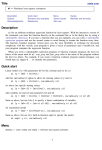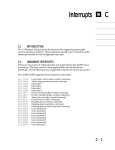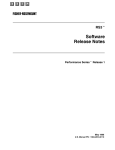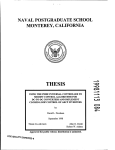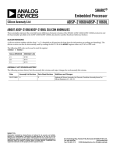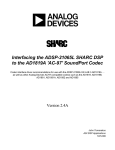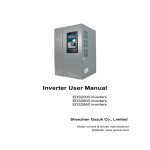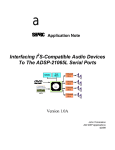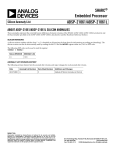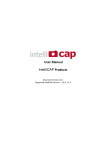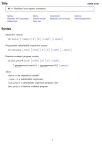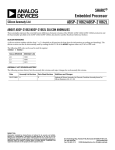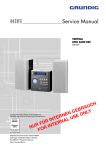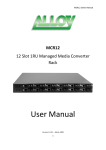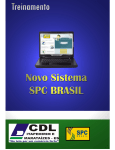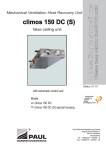Download Engineer-To-Engineer Note EE
Transcript
Engineer-To-Engineer Note EE-74 Technical Notes on using Analog Devices’ DSP components and development tools Phone: (800) ANALOG-D, FAX: (781) 461-3010, EMAIL: [email protected], FTP: ftp.analog.com, WEB: www.analog.com/dsp Copyright 1999, Analog Devices, Inc. All rights reserved. Analog Devices assumes no responsibility for customer product design or the use or application of customers’ products or for any infringements of patents or rights of others which may result from Analog Devices assistance. All trademarks and logos are property of their respective holders. Information furnished by Analog Devices Applications and Development Tools Engineers is believed to be accurate and reliable, however no responsibility is assumed by Analog Devices regarding the technical accuracy of the content provided in all Analog Devices’ Engineer-to-Engineer Notes. Analog Devices Serial Port Development and Troubleshooting Guide Compiled by the Analog Devices DSP Applications group Introduction The purpose of this document is to assist engineers in the design and debugging of serial port communications in systems using Analog Devices’ DSPs. First, it will cover general system design strategies to help ensure low noise levels and valid signals throughout the system. Next, it will focus on common serial port problems and their respective solutions. This section is processor nonspecific. The following section deals with processor specific issues, these being the ADSP21xx family and the ADSP2106x family of DSPs. Finally, there is a section containing example serial-port initialization code for both families of DSPs. General ADSP-21xx / 2106x DSP SPORT Design Issues (Note: because the serial ports on both the ADSP21xx and ADSP2106x families of DSPs are very similar in architecture and functionality, the issues presented in the section apply to both) Perhaps one of the largest cause of serial port problems is poor board design. The serial ports are essentially edge-triggered state machines - this means that every time a valid edge occurs on a serial clock line, the state machine is stimulated. A valid edge occurs when the voltage level on a serial port line passes across approximately 2.5 Volts in 5 Volt parts and 1.3 Volts in 3.3V parts - we will refer to this as the critical voltage. If the serial clock is set to ‘positive edge’ polarity (configurable in serial port control register), a valid edge occurs when the voltage on the serial clock line passes from below the critical voltage to above the critical voltage. On the other hand, if the serial clock is set to ‘falling edge’ polarity, a valid edge occurs when the voltage passes from above the critical voltage to below the critical voltage. a Positive Edge Polarity vali d Negative Edge Polarity Vcc Critical point Vcc vali d Critical point Vdd Vdd Figure 1 : Positive and Negative Edge Polarity There are many design related problems that can cause noisy serial clock lines which can potentially cross the critical voltage multiple times per one clock pulse. The example below presents two variations of the same serial clock signal - one has a large signal reflection which causes each period of the serial clock to cross the critical point multiple times. This will cause the state machine within the serial port to sample the serial data lines twice per clock period causing the serial data to become corrupted. The other signal is properly compensated so no reflections occur and the data is sampled once per period. This signal does not contain reflections This signal contains reflections Figure 2: Signals with reflections The following sections present specific design strategies to avoid problems like this one. Decoupling the DSP’s Vcc and GND Pins The DSP should have a .1µF capacitor connected between each of its Vcc and Gnd (Vdd) pins. This helps keep the power supply to the DSP clean of voltage spikes and dips on the Vcc and Gnd lines. Large spikes and dips in the Vcc and Gnd lines can cause the processor to jump into an unknown state potentially causing the processor to crash. These capacitors should be placed as close as possible to the actual Vcc and Gnd pins of the chip for maximum effectiveness. Hardware Construction (PCB vs. Wirewrap) EN-74 Page 2 Technical Notes on using Analog Devices’ DSP components and development tools Phone: (800) ANALOG-D, FAX: (781) 461-3010, FTP: ftp.analog.com, EMAIL: dsp.support @analog.com Signal Trace Length Serial lines greater than about 3” will require some sort of reflection compensation. Details about this are covered in the solutions section. Common Serial Port Problems This section is a troubleshooting guide. Each problem listed below contains a description of why it exists and some techniques to isolate a specific cause. Once the cause is determined, a reference is provided for the solutions table where conveniently enough, solutions can be found. DSP is Receiving and/or Transmitting Corrupt Data First ensure that the device communicating with the DSP is operating correctly. If the DSP is receiving corrupt data, it may be because the device it is communicating with is transmitting corrupt data. If it is, make sure that the signals that it is generating are clean, meet required timing specs and have good levels. Below is an example of communications system where data is being corrupted: Serial Clock DSP 1 Serial Data DSP 2 Frame Sync Shifted Data: When serial data received by DSP 2 is a shifted version of the data transmitted by DSP 1, this usually means there is a data synchronization problem. This is often common when transmitting unframed data and can be caused by a noisy serial clock or system noise. Below are a few examples of 8-bit data words which have been shifted during the transmission from DSP 1 to DSP 2. Data Sent from DSP 1: 10101010 11110000 00001111 Data Received by DSP 2: 01010101 01111000 00011111 See items: EN-74 Page 3 Technical Notes on using Analog Devices’ DSP components and development tools Phone: (800) ANALOG-D, FAX: (781) 461-3010, FTP: ftp.analog.com, EMAIL: dsp.support @analog.com Incorrect Bits: When serial data received by DSP 2 contains corrupted bits, there is usually a system noise problem. Below are a few examples where 8-bit data words transmitted from DSP 1 to DSP 2 have become corrupted. Data Sent from DSP 1: 10101010 11110000 00001111 Data Received by DSP 2: 10101110 10110010 01001111 No activity on serial port lines When the serials ports are not enabled, the serial port signals are tristated. Invalid line levels on serial port lines Invalid line levels will occur when two devices are trying to drive the serial port. If one part is driving a serial port line high and another is driving it low at the same time the resulting voltage on that line while be somewhere between Vcc and Gnd. This can also damage one of the Noise on serial port lines Solutions Table Proper termination of long SPORT traces SPORT_Tech_Note.pd f The serial port on the DSP is very sensitive to any external noise in the system. This includes noise due to reflections on the lines, signal degradation due to long trace lengths, and signal interference. Any trace that is equal to or longer than 3--4 inches has to be treated as a transmission line at the high frequencies that the SPORT generally operates at, and must be properly terminated to reduce noise and glitches on the lines. Failure to do so may result in the SPORT locking up, or the SPORT transmitting or receiving incorrect data. In addition EN-74 Page 4 Technical Notes on using Analog Devices’ DSP components and development tools Phone: (800) ANALOG-D, FAX: (781) 461-3010, FTP: ftp.analog.com, EMAIL: dsp.support @analog.com to good board layout and design considerations (refer High Speed Digital design book), a popular method to reduce noise is to provide series termination resistors on the SPORT control lines, as close to the DSP generating the signals as possible(preferably right next to the DSP).The value of the resistor typically ranges between 20-100 ohms, but an exact value depends on the trace lengths and the characteristic impedance of the line. Values can be determined by using an equation described in the book “High-Speed Digital Design-A Handbook of Black Magic” by Howard W. Johnson and Martin Graham, and published by Prentice-Hall. If the total electrical delay of the signal net in questions is greater than six times the rise or fall time of the source, you should terminate the signal. Rough calculations of the total line length delay of the net should be calculated with 0.180ns per inch and 2 pF per inch. Example 1: A driver is connected to 6 loads, each load is 8pf, the connection is a star connection, where the longest path from the driver is 15 inches, the output impedance of the driver is 10 ohms, and the rise / fall time of the driving signal is 2.0 ns max. The max. rise and fall times of the Driving Signal is 2 ns. The Total Signal trace delay is (15 * .180 ns) this is 2.7 ns. The Total RC load delay is ((8 pF * 6) + (15 * 2 pF) * 10 ohms = 0.780 ns Then the ratio of signal delay to rise time is signal delay / rise time equals 3.48 ns / 2.0 ns = 3.48 The ratio is less than 6, so this signal should be OK, and Terminations would not be required. Example 2: A driver is connected to 6 loads, each load is 8pf, the connection is a star connection, where the longest path from the driver is 30 inches, the output impedance of the driver is 15 ohms, and the rise / fall time of the driving signal is 1.0 ns max. The max. rise and fall times of the Driving Signal is 1 ns. The Total Signal trace delay is (24 * .180 ns) this is 5.4 ns. The Total RC load delay is ((8 pF * 6) + (30 * 2 pF) * 10 ohms = 1.00 ns Then the ratio of signal delay to rise time is signal delay / rise time equals 6.4 ns / 1.0 ns = 6.4 The ratio is greater than 6, this signal would cause reflection problems, and terminations should be used. For a series termination: The termination value should be the PWB characteristic impedance minus the driver output impedance. Example: Assuming a PWB Z of 50 ohms, and Driver Z of 10 ohms, then the series termination located as close to the driver as possible would be 40 ohms. EN-74 Page 5 Technical Notes on using Analog Devices’ DSP components and development tools Phone: (800) ANALOG-D, FAX: (781) 461-3010, FTP: ftp.analog.com, EMAIL: dsp.support @analog.com For a end termination (parallel split termination): The parallel equivalent termination value should be the PWB characteristic impedance. Example: Assuming a PWB Z of 50 ohms, then the parallel equivalent split termination values located as close to the end of the line as possible would be 50 ohms. You should not exceed IOH Max and IOL Max of the Driver. After establishing the 2 resistor values for the termination (for most CMOS logic the ratio should be the ratio of IOH and IOL), calculate the current through the two resistors based on the VOH and VOL, if the current in either case exceeds IOH Max or IOL Max, you should not use a end termination arrangement. Processor Specific Issues 21xx The questions and answers provided in this Tech-note are based on commonly asked questions from customers, or information that is not documented extensively in the ADSP-2100 Family User’s manual, and is intended to supplement the information provided therein. The serial ports have the capability of transmitting and receiving serial data in the form of bits, with the MSB first. Bits are clocked in at the rate of the serial port clock (which can either be internally generated by the DSP as a fraction of the processor clock (CLKOUT), or externally generated by another device, and supplied to the DSP). Bits are transmitted on the rising edge of an SCLK pulse, and received on the falling edge of an SCLK pulse. The frame sync signal is used to signify the start of a serial data word or stream of serial words. Continuous mode of operation of Serial Port The ADSP-2100 Family User’s manual (third edition) describes the operation of the SPORTs in continuous mode (for example, refer section 5.9 on timing examples on page 5-16). The serial port is said to operate in the continuous mode while either transmitting or receiving, if a bit is shifted out or in with every SCLK pulse, without a pause. This is not a special mode of operating the serial port, and hence there is no register or bit associated with it. The value in the RFSDIV register determines the operation. For example, to set the serial port up in this mode, with an internal RFS and alternate framing, set RFSDIV to be equal to the SLEN-1. Internal generation of transmit and receive frame syncs with frame syncs NOT required If a serial port is set for internal frame sync(transmit or receive) and the SPORT x Control register is configured for “frame-sync-not-required”, (in other words, bits 11 and/or 13--the RFSR and the TFSR set to 0), the serial port continues to generate a frame sync for every transmitted or received word. In other words, operation of the SPORT is identical for either mode. The main difference is seen at the receiving end where if the SPORT is set up for external frame sync, the DSP ignores the frame sync after the initial pulse. EN-74 Page 6 Technical Notes on using Analog Devices’ DSP components and development tools Phone: (800) ANALOG-D, FAX: (781) 461-3010, FTP: ftp.analog.com, EMAIL: dsp.support @analog.com Disabling and Re-enabling SPORTs At any time after a serial port is disabled, if it is necessary to re-enable it, it is recommended that the control registers corresponding to the serial port be set up again before the SPORT is re-enabled. If a serial port is set for internal frame sync and is then enabled, the first frame sync appears after RFSDIV serial clock cycles. When a serial port is set for internal frame sync and alternate mode, the smallest number that be written into the RFSDIV register is the number of bits in each word. This is because the frame sync is active throughout the length of the word. Enabling SPORTS It is critical that the RFSDIV register is set before enabling the sports. When the sports are enabled the register will count to zero and you will get the receive frame sync 1-2 cycles later. The total is n + (1 or 2) 1 cycle if in alternate frame mode 2 cycle if in normal frame mode where n is the value of the receive count register Use of gated serial clocks with the serial port We strongly recommend the use of a continuous serial clock(internally generated by the DSP), or external for the serial port. The reason for this is because of the latency involved, in that the DSP requires a few cycles to synchronize the serial port after it receives the first serial clock pulse. However, if it is imperative for the specific application to use a gated serial clock, it is important to ensure that the clock is not discontinued in the middle of receiving or transmitting a word. Disabling SPORT autobuffering temporarily If a certain application requires the SPORT to be set up to receive a known number of words while using autobuffering, and the user wishes to stop receiving words for some period of time before re-enabling it, two options are available. The first is to disable autobuffering in the SPORTx receive interrupt service routine and disable the SPORT. The SPORT continues to receive/transmit words until and unless autobuffering is disabled. One must be aware of the latencies involved while re-enabling the SPORT at a future time. The second option is to disable autobuffering and to simply mask off the SPORTx interrupt. This will cause the SPORT to shift in words into the RXx register, but not interrupt the DSP. The following simple example illustrates how this is done for the SPORT0 receiving data, on the ADSP-218x. A similar procedure can be followed for SPORTx transmit interrupt. SPORTx_RCV: AX0 = B#0xxxxxxxxxxxxxx0; DM(Sportx_Autobuf_Ctrl) = AX0; POP STS; IMASK = B#xxxx0xxxxx; EN-74 Page 7 Technical Notes on using Analog Devices’ DSP components and development tools Phone: (800) ANALOG-D, FAX: (781) 461-3010, FTP: ftp.analog.com, EMAIL: dsp.support @analog.com PUSH STS; ...... RTI; It is necessary to manually pop and push the status register because the original IMASK was pushed onto the stack before the interrupt is serviced. To re-enable the SPORT at some future time, (it is possible to use an interrupt or a flag from the transmitter to let the receiving DSP know it is ready to transmit again) it is only necessary to set the corresponding bit in the IMASK register, in other words to H#xxxx1xxxxx, and re-enable the autobuffering. Once the receiving DSP has done this, it can indicate to the transmitter that it is ready to receive the next set of words. Startup Time “When a serial port is enabled by a write to the System Control Register, it takes two SCLK cycles before it is actually enabled. On the next (third) SCLK cycle, the serial port becomes active, looking for a frame sync.” The SPORT was designed this way to synchronize the enable signal to the asynchronous serial clock. To the clocked serial port, it appears that any cycle could be the start of a frameless data stream; there is a valid frame signal every cycle. This causes the SPORT to skip the data on the first two or three cycles of SCLK if you are not giving any cycles without the frame signal, since it ignores the frame signal until the SPORT becomes active. This situation can happen to anyone using frameless modes with the clock only operating when data is being sent. The solution of sending a couple dummy bits will work fine if the SPORT is enabled long before the SCLK starts, but could cause trouble if the enable bit is written at about the same time as the first SCLK cycle. An alternate solution would be to have the frame signal de-asserted for 2 or more SCLK cycles, and than asserted when the data starts. Some other processors have a special asynchronous start mode to better support the "toggle the clock only when there is data" type of operation. SHARC Changing Multichannel TX and RX Channel Selects: The MTCSx bits can be changed while the serial port is active as long as the current channel, STCTLx(CHNL), does not correspond to timeslot of the changed bits. It is possible that the current channel can change to the next channel after STCTLx(CHNL) is read. So writing to MTCSx must be avoided when the value of STCTLx(CHNL) is equal to or one less than that of the timeslot for the changed bits in MTCSx. Changing MRCSx can occur at any time, there is no problem even if the current channel corresponds to changed bit of MRCSx. Changing Multichannel TX and RX Companding Selects: EN-74 Page 8 Technical Notes on using Analog Devices’ DSP components and development tools Phone: (800) ANALOG-D, FAX: (781) 461-3010, FTP: ftp.analog.com, EMAIL: dsp.support @analog.com The MTCCS and MRCCS bits are read during the transmission/reception of the last bit of the current channel to about the time when the 2ndbit of next channel is transmitted. So these bits should not change in this window of about 2 serial clock cycles. Since this window overlaps the current channel and the next channel, we can follow the same rule which we do for MTCS bits. This means that we should avoid changing the MTCCS and MRCCS bits when the changed bits corresponds to channel number. STCTL(CHAN) and STCTL(CHAN) + 1. He was very concerned about a possible contention on the DTx pin of SPORT0 for multiple 218x dsp's in multi-channel mode transmitting in adjacent channels with the frame delay = 0. He felt that there was a potential 15ns of overlap in transmitting for the last bit of one channel to the first bit in the next channel. The particular specs of interest are Tscde and Tscdd. In the schematics for the circuitry of the SPORT he found that there is a single signal that controls the enable/disable of data transmission. The min for Tscde comes from the case where SPORT DTx was enabled in the previous SCLK cycle and therefore no transition takes place. The max. spec for Tscdd comes from the case where SPORT DTX was enabled in the previous SCLK cycle and therefore a transition to disable is necessary. From this it is apparent that since both 218x's will be transitioning at the overlap (one from enable to disable and the other from enable to disable), each will experience very close to the same delay and therefore the overlap will be very small and the contention will be negligible. 1. Does the SPORT need an input on TCLK, or does the transmitter use RCLK for transmitting in multichannel mode? If it does use RCLK, what should we do with TCLK input? ANS: On same SPORT, the DT & DR lines are connected together. The TCLK input can be left floating. 2. What does the transmitter send after it completes sending all the data in its transmit data buffer and no other data is written to it? ANS: It tristates the DT line. 3. Does bit CKRE of STCTL do anything in multichannel mode since the transmit side is using RFS? ANS: No Example Code Part 1: 21xx Serial Port Initialization Code This example code configures an ADSP21xx DSP for multichannel serial communications using autobuffering. Clock and RFS are generated externally. EN-74 Page 9 Technical Notes on using Analog Devices’ DSP components and development tools Phone: (800) ANALOG-D, FAX: (781) 461-3010, FTP: ftp.analog.com, EMAIL: dsp.support @analog.com .MODULE/RAM/ABS=0 MultiChannelSPORT; Variable Declaration & Initialization #include <constant.k>; .var/dm/circ .var/dm/circ txbuffer[12]; rxbuffer[12]; .init txbuffer : <2181.dat>; /* test file used Interrupt Vector Table /* IRQ vector table */ jump start; rti; rti; rti; rti; rti; rti; jump rti; rti; rti; rti; /* rti; rti; rti; /* rti; rti; rti; /* TXIRQ; rti; rti; rti; rti; rti; rti; /* rti; rti; rti; rti; jump rti; rti; rti; rti; rti; rti; rti; rti; rti; TimerIRQ; rti; rti; /* jump over interrupt vectors */ code vectors here upon IRQ2 interrupt */ code vectors here upon IRQL1 interrupt */ code vectors here upon IRQL0 interrupt */ /* code vectors here upon SPORT0 TX interrupt */ code vectors here upon SPORT0 RX interrupt */ rti; /* code rti; /* code rti; /* code rti; /* code rti; rti; rti; rti; /* code vectors here upon vectors here upon vectors here upon vectors here upon /* code vectors vectors here upon IRQE interrupt */ BDMA interrupt */ SPORT1 TX (IRQ1) interrupt */ SPORT1 RX (IRQ0) interrupt */ here upon TIMER interrupt */ POWER DOWN interrupt */ System Initialization Code 1. Set imask to enable only transmit interrupt. start: /* Configure System Register imask = b#0001000000; /* |||||||||+ | ||||||||+- | |||||||+-- | ||||||+--- | |||||+---- | ||||+----- | |||+------ | ||+------- | |+-------- | +--------- | */ 2. */ timer SPORT1 SPORT1 BDMA IRQE SPORT0 SPORT0 IRQL0 IRQL1 IRQ2 rec or IRQ0 trx or IRQ1 rec trx Set icntl to disable interrupt nesting and to make all IRQ interrupts edge sensitive icntl = b#00111; EN-74 Page 10 Technical Notes on using Analog Devices’ DSP components and development tools Phone: (800) ANALOG-D, FAX: (781) 461-3010, FTP: ftp.analog.com, EMAIL: dsp.support @analog.com /* ||||+|||+-||+--|+---+----- | | | 0 | IRQ0: 0=level, 1=edge IRQ1: 0=level, 1=edge IRQ2: 0=level, 1=edge IRQ nesting: 0=disabled, 1=enabled */ 3. Set mstat mstat = b#1100000; /* ||||||+- | |||||+-- | ||||+--- | |||+---- | ||+----- | |+------ | +------- | */ Data register bank select FFT bit reverse mode (DAG1) ALU overflow latch mode, 1=sticky AR saturation mode, 1=saturate, 0=wrap MAC result, 0=fractional, 1=integer timer enable GO MODE 4. Set System Control Register to enable SPORT 0 /* System Control Register */ ax0 = b#0001000000000000; /* xxx!||+-----/+-/| !||| | !||| | !||+---------| !|| | !|| | !|| | !|| | !|| | !|| | !|+----------| !+-----------| +============= +---------------*/ dm (System_Control_Reg) = ax0; | program memory wait states | 0 | 0 0 0 0 0 0 0 SPORT1 1=serial, 0=FI, FO, IRQ0, IRQ1, SCLK SPORT1 1=enabled, 0=disabled SPORT0 1=enabled, 0=disabled 0 Serial Port Initialization Code 1. Set SPORT0 control register /* SPORT0 Control Register */ ax0 =b#1000010000001111; /* ||\ /||||\|++++ || \| |||| +---|| | |||+-----|| | ||+------|| | |+-------|| | +--------|| | || | EN-74 dm (SPORT0_Control_Reg) = ax0; - SLEN (serial word length - 1) - DTYPE (date format) - INVRFS (Invert RFS signal) - INVTFS (Invert TFS signal) - IRFS (Internal RFS enable) - ITFS (or multichannel len 1=32) Page 11 Technical Notes on using Analog Devices’ DSP components and development tools Phone: (800) ANALOG-D, FAX: (781) 461-3010, FTP: ftp.analog.com, EMAIL: dsp.support @analog.com || +----------|| |+-------------+--------------*/ 2. - Multiframe delay - ISLCK (Internal clock generation) - Multichannel enable Set multichannel transmit and receive channels (receive on even, transmit on odd). /* Tx and Rx Word Enable Register (for multichannel) */ 3. ax0 = b#1010101010101010; ax0 = b#1010101010101010; dm (SPORT0_RX_Channels1) = ax0; dm (SPORT0_RX_Channels0) = ax0; ax0 = b#0101010101010101; ax0 = b#0101010101010101; dm (SPORT0_TX_Channels1) = ax0; dm (SPORT0_TX_Channels0) = ax0; Set clock divisions to zero since they’re not being generated in the 2181. /* Receive FS and clock divisions = 0 */ ax0 = 0x0; dm(0x3FF4) = ax0; dm(0x3FF5) = ax0; 4. Setup Autobuffering. /* Autobuffering control registers */ ax0 =b#0000001000000011; dm (SPORT0_Autobuf) = /* x|x|\ /\|\ /\||+- - RBUF (Receive buffer | | | | | |+-- - TBUF (Transmit buffer | | | | | +--- - RMREG | | | | +------ - RIREG | | | +-------- - TMREG | | +----------- - TIREG | +------------- - BIASRND +--------------- - CLKODIS ax0; enable) enable) */ i0 = ^rxbuffer; m0 = 1; l0 = %rxbuffer; i1 = ^txbuffer; l1 = %txbuffer; /* Configure DAG's for autobuffering */ EN-74 Page 12 Technical Notes on using Analog Devices’ DSP components and development tools Phone: (800) ANALOG-D, FAX: (781) 461-3010, FTP: ftp.analog.com, EMAIL: dsp.support @analog.com Main Loop Wait for an interrupt and service it. ena ints; WaitLoop: IDLE; jump WaitLoop; Transmit Interrupt Service Routine Here we reinitializing the transmit and receive buffers TXIRQ: i0 = ^rxbuffer; i1 = ^txbuffer; rti; .endmod; Part 2: ADSP2106x Serial Port Initialization Code This example code configures an ADSP2106x DSP for multichannel serial communications using DMA. Clock and RFS are generated internally. #define Channels 24 #include "def21060.h" .EXTERN .EXTERN .EXTERN .EXTERN setup_1847; spt0_asserted; rx_buf, tx_buf; input_samples; /* Initialize variables */ .segment/dm seg_dmda; .var TXData[12] = "Sharc.dat"; .var RXData[12]; .var samples[323]; .endseg; Interrupt Vector Table /* Reset */ .segment/pm EN-74 seg_rth; Page 13 Technical Notes on using Analog Devices’ DSP components and development tools Phone: (800) ANALOG-D, FAX: (781) 461-3010, FTP: ftp.analog.com, EMAIL: dsp.support @analog.com // The kernel begins with the interrupt table. // Reserved interrupt, IRPTL bit 0, Vector 0x00 ___lib_RSRV0: NOP; NOP; NOP; NOP; // Reset vector (read-only, non-maskable): // This needs to be kept, to start the kernel monitor program. ___lib_RSTI: IDLE; // Implicit IDLE instruction. JUMP startup; RTI; RTI; // Reserved interrupt, IRPTL bit 2, Vector 0x08 ___lib_RSRV1: NOP; NOP; NOP; NOP; // Vector for status stack/loop stack overflow or PC stack full: // Stack overflow, IRPTL bit 3, Vector 0x0c ___lib_SOVFI: RTI; RTI; RTI; RTI; // High priority timer interrupt, IRPTL bit 4, Vector 0x10 ___lib_TMZHI: RTI; RTI; RTI; RTI; // Vector Interrupt, IRPTL bit 5, Vector 0x14 ___lib_VIRPTI: RTI; RTI; RTI; RTI; // IRQ2, IRPTL bit 6, Vector 0x18 // This vector is used for the UART. ___lib_IRQ2I: RTI; RTI; RTI; RTI; // IRQ1, IRPTL bit 7, Vector 0x1c ___lib_IRQ1I: RTI; /* pluck "string" */ RTI; RTI; RTI; // IRQ0, IRPTL bit 8, Vector 0x20 ___lib_IRQ0I: RTI; RTI; RTI; RTI; // Reserved interrupt, IRPTL bit 9, Vector 0x24 ___lib_RSRV2: NOP; NOP; NOP; NOP; // DMA 0 (Sport 0 Rcv), IRPTL bit 10, Vector 0x28 ___lib_SPR0I: jump input_samples; RTI; RTI; RTI; // DMA 1 (Sport 1 Rcv / LBUF 0), IRPTL bit 11, Vector 0x2c ___lib_SPR1I: RTI; RTI; RTI; RTI; // DMA 2 (Sport 0 Xmt), IRPTL bit 12, Vector 0x30 ___lib_SPT0I: jump spt0_asserted; RTI; EN-74 RTI; RTI; Page 14 Technical Notes on using Analog Devices’ DSP components and development tools Phone: (800) ANALOG-D, FAX: (781) 461-3010, FTP: ftp.analog.com, EMAIL: dsp.support @analog.com // DMA 3 (Sport 1 Xmt / LBUF 1), IRPTL bit 13, Vector 0x34 ___lib_SPT1I: jump TXIRQ; RTI; RTI; RTI; // DMA 4 (LBUF 2), IRPTL bit 14, Vector 0x38 ___lib_LP2I: RTI; RTI; RTI; RTI; // DMA 5 (LBUF 3), IRPTL bit 15, Vector 0x3c ___lib_LP3I: RTI; RTI; RTI; RTI; // DMA 6 (EPB 0 / LBUF 4), IRPTL bit 16, Vector 0x40 ___lib_EP0I: RTI; RTI; RTI; RTI; // DMA 7 (EPB 1 / LBUF 5), IRPTL bit 17, Vector 0x44 ___lib_EP1I: RTI; RTI; RTI; RTI; // DMA 8 (EPB 2), IRPTL bit 18, Vector 0x48 ___lib_EP2I: RTI; RTI; RTI; RTI; // DMA 9 (EPB 3), IRPTL bit 19, Vector 0x4c ___lib_EP3I: RTI; RTI; RTI; RTI; // Link service request, IRPTL bit 20, Vector 0x50 ___lib_LSRQ: RTI; RTI; RTI; RTI; // DAG1 buffer 7 circular buffer overflow, IRPTL bit 21, Vector 0x54 ___lib_CB7I: RTI; RTI; RTI; RTI; // DAG2 buffer 15 circular buffer overflow, IRPTL bit 22, Vector 0x58 ___lib_CB15I: RTI; RTI; RTI; RTI; // Low priority timer interrupt, IRPTL bit 23, Vector 0x5c ___lib_TMZLI: RTI; /* pluck "string" */ RTI; RTI; RTI; // Fixed point overflow exception, IRPTL bit 24, Vector 0x60 ___lib_FXOVF: RTI; RTI; RTI; RTI; // Floating point overflow exception, IRPTL bit 25, Vector 0x64 ___lib_FPOVF: RTI; RTI; RTI; RTI; // Floating point underflow exception, IRPTL bit 26, Vector 0x68 ___lib_FPUNF: RTI; RTI; RTI; RTI; // Floating point invalid exception, IRPTL bit 27, Vector 0x6c ___lib_FPINV: RTI; RTI; RTI; RTI; EN-74 Page 15 Technical Notes on using Analog Devices’ DSP components and development tools Phone: (800) ANALOG-D, FAX: (781) 461-3010, FTP: ftp.analog.com, EMAIL: dsp.support @analog.com // User SW interrupt 0, IRPTL bit 28, Vector 0x70 ___lib_USW0: RTI; RTI; RTI; RTI; // User SW interrupt 1, IRPTL bit 29, Vector 0x74 ___lib_USW1: RTI; RTI; RTI; RTI; // User SW interrupt 2, IRPTL bit 30, Vector 0x78 ___lib_USW2: RTI; RTI; RTI; RTI; // User SW interrupt 3, IRPTL bit 31, Vector 0x7c ___lib_USW3: RTI; RTI; RTI; RTI; .endseg; Main Code Segment In this segment of code, we initialize the 1847, serial ports and DMA. Then, interrupts are enabled and we wait for one to occur. /* Code Starts Here ! */ .segment/pm seg_pmco; startup: Call setup_1847; /* Initalize the codec */ Call ConfigSPORT; Call ConfigDMA; bit bit bit bit clr set set set imask imask mode1 astat SPR1I; /* Unmask transmit and receive interrupts */ SPT1I; IRPTEN; /* Enable all interrupts */ FLG2; waiting: nop; jump waiting; Transmit Interrupt Service Routine In order to initialize a new DMA transfer after a previous transfer has completed, the following steps must be taken: The DMA enable bit must be cleared in the Serial Port Transmit Control Register. 2) The DMA control registers (II1, IM1, C1) must be reloaded. 1) EN-74 Page 16 Technical Notes on using Analog Devices’ DSP components and development tools Phone: (800) ANALOG-D, FAX: (781) 461-3010, FTP: ftp.analog.com, EMAIL: dsp.support @analog.com 3) The DMA enable bit must be set in the Serial Port Transmit Control Register. TXIRQ: r1 = b#11111111111110111111111111111111; r0 = dm(STCTL1); /* Reset DMA */ r2 = r1 and r0; dm(STCTL1) = r2; /* Clear DMA Enable bits of serial control regs */ r0 = dm(SRCTL1); r2 = r1 and r0; dm(SRCTL1) = r2; Call ConfigDMA; /* Reset DMA registers */ r1 = not r1; r0 = dm(STCTL1); r2 = r1 xor r0; dm(STCTL1) = r2; /* Set DMA Enable bits of serial control regs */ r0 = dm(SRCTL1); r2 = r1 xor r0; dm(SRCTL1) = r2; rti; Talkthru Running on Serial Port 0 This takes samples from the serial port 0 receive register. and puts them in the transmit registers. input_samples: r15 = dm(rx_buf + 1); dm(tx_buf + 1) = r15; r15 = dm(rx_buf + 2); dm(tx_buf + 2) = r15; rti; Serial Port Initialization Code ConfigSPORT: 1. Set channels to transmit and receive on. transmitting on the even channels. Here we are receiving on the odd channels and /* Multichannel Receive Select */ r0 = 0x55555555; dm(MRCS1) = r0; EN-74 Page 17 Technical Notes on using Analog Devices’ DSP components and development tools Phone: (800) ANALOG-D, FAX: (781) 461-3010, FTP: ftp.analog.com, EMAIL: dsp.support @analog.com /* Multichannel Transmit Select */ r0 = 0xAAAAAAAA; dm(MTCS1) = r0; 2. Set data companding bits if we want to use this feature. /* Multichannel Companding Select */ r0 = 0; dm(MTCCS1) = r0; dm(MRCCS0) = r0; /* No companding on either tx or rx */ 3. Set SCLK and RFS rates. /* Receive Divisors */ r0 = 0x01900028; dm(RDIV1) = r0; /* set RCLKDIV at 1MHz or 40 divisions*/ /* set RFSDIV at 2500 Hz or 16,000 divisions*/ /* Transmit Divisors */ r0 = 0x01900198; dm(TDIV1) = r0; /* same as receive? */ 4. Set transmit control register /* SPORT1 Transmit Register */ r0 =b#00000000000100000000000011110000; dm(STCTL1) = r0; |/|\|||/\||/||||||||x||\|||/|\|+---- Sport Enable | | \|/ / |||||||| || \|/ | +----- Data Type | | | | |||||||| || | +------- Serial Word Endian (1=MSB first) | | | | |||||||| || +---------- Serial Word Length | | | | |||||||| |+------------- Pack (1=pack) | | | | |||||||| +-------------- Int Generated Transmit Clock (1=int) | | | | |||||||+---------------- Clock Edge for data (1=rising) | | | | ||||||+----------------- TFS Required (1=yes) | | | | |||||+------------------ Int Generated TFS (1=int) | | | | ||||+------------------- Data Independant TFS (1=yes) | | | | |||+-------------------- Active Low TFS (1=yes) | | | | ||+--------------------- Late TFS (1=yes) | | | | |+---------------------- SPORT Tx DMA Enabled (1=ena) | | | | +----------------------- SPORT Tx DMA Chaining (1=ena) | | | | | | | | | | | +------------------------- Multichannel frame delay = 1 | | +------------------------------ Current Channel Select | +--------------------------------- Transmit Underflow Status (read /* - only) +----------------------------------- TX Data Buffer Status (read - only) */ EN-74 Page 18 Technical Notes on using Analog Devices’ DSP components and development tools Phone: (800) ANALOG-D, FAX: (781) 461-3010, FTP: ftp.analog.com, EMAIL: dsp.support @analog.com 5. Set receive control register /* SPORT1 Receive Register */ r0 =b#00010111100000000100010011110000; dm(SRCTL1) = r0; |/|\|||/|||x||||x|||x||\|||/|\|+---- Sport Enable | | \|/ ||| |||| ||| || \|/ | +----- Data Type | | | ||| |||| ||| || | +------- Serial Word Endian | | | ||| |||| ||| || +---------- Serial Word Length | | | ||| |||| ||| |+------------- Pack (1=pack) | | | ||| |||| ||| +-------------- Int Generated Receive Clock (1=int) | | | ||| |||| ||+---------------- Clock Edge for data (1=rising) | | | ||| |||| |+----------------- Rvs Required (1=yes) | | | ||| |||| +------------------ Int Generated RFS (1=int) | | | ||| |||+-------------------- Active Low RFS (1=yes) | | | ||| ||+--------------------- Late RFS (1=yes) | | | ||| |+---------------------- SPORT Rx DMA Enabled (1=ena) | | | ||| +----------------------- SPORT Rx DMA Chaining (1=ena) | | | ||+------------------------- 2D DMA | | | |+-------------------------- SPORT Loobback | | | +--------------------------- Multichannel enable (1=yes) | | +------------------------------ Number of Channels - 1 | +--------------------------------- reveive Overflow Status (read - only) +----------------------------------- RX Data Buffer Status (read - only) /* */ rts; DMA Initialization Code Here we are setting the I, M and C registers of DMA channel 1 (SPORT 0 receive) and DMA channel 3 (SPORT 0 transmit) ConfigDMA: /*DMA Channel 1 used for SPORT0 RX*/ r0 = RXData; dm(II1) = r0; r0 = 1; dm(IM1) = r0; r0 = 12; dm(C1) = r0; /*DMA Channel 3 used for SPORT0 TX*/ r0 = TXData; dm(II3) = r0; r0 = 1; dm(IM3) = r0; r0 = 12; dm(C3) = r0; rts; EN-74 Page 19 Technical Notes on using Analog Devices’ DSP components and development tools Phone: (800) ANALOG-D, FAX: (781) 461-3010, FTP: ftp.analog.com, EMAIL: dsp.support @analog.com .endseg; That’s all, folks! EN-74 Page 20 Technical Notes on using Analog Devices’ DSP components and development tools Phone: (800) ANALOG-D, FAX: (781) 461-3010, FTP: ftp.analog.com, EMAIL: dsp.support @analog.com




















